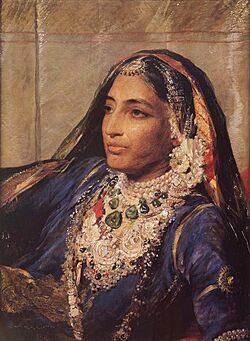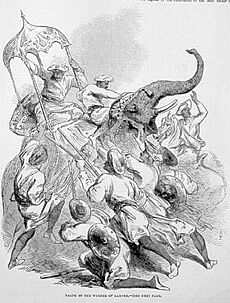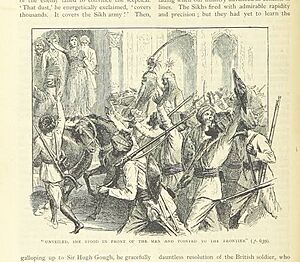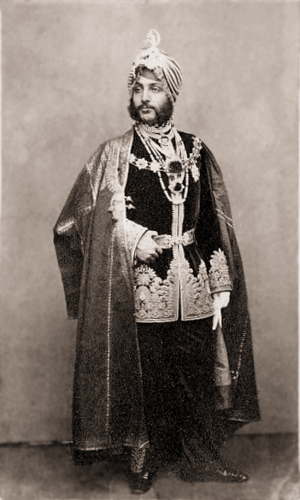Jind Kaur facts for kids
Quick facts for kids Maharani Jind Kaur |
|
|---|---|
| 2nd Maharani of the Sikh Empire | |

Maharani Jind Kaur at 45
(Portrait by George Richmond) |
|
| Maharani of the Sikh Empire | |
| Tenure | c. 1847 (nominal power) |
| Predecessor | Duleep Singh (as Maharaja) |
| Successor | Sikh Empire annexed by East India Company |
| Regent of the Sikh Empire | |
| Regency | c. 1843 – c. 1847 |
| Monarch | Duleep Singh |
| Born | 1817 Chichrianwali, Gujranwala, Sikh Empire (present-day Punjab, Pakistan) |
| Died | 1 August 1863 (aged 45) Kensington, Middlesex, United Kingdom |
| Spouse | Maharaja Ranjit Singh (m.1829; died 1839) |
| Issue | Maharaja Duleep Singh |
| House | Sukerchakia (by marriage) |
| Father | Manna Singh Aulakh |
| Religion | Sikhism |
Maharani Jind Kaur (born around 1817 – died August 1, 1863) was a very important leader in the Sikh Empire. She was the regent, which means she ruled for her young son, from 1843 to 1847. After the Sikh Empire ended in 1847, many Sikhs still saw her as their true Queen. However, the British took full control and did not agree.
Jind Kaur was the youngest wife of Ranjit Singh, who was the first Maharaja (King) of the Sikh Empire. She was also the mother of Duleep Singh, the last Maharaja. People knew her for her beauty, energy, and strong will. The British in India were quite afraid of her power and influence.
When Duleep Singh became Maharaja in September 1843, he was only 5 years old. So, Jind Kaur became the regent to rule on his behalf. After the Sikhs lost the First Anglo-Sikh War, the British tried to reduce her power. They replaced her with a council in 1846, but she still had a lot of influence. Because of this, the British put her in prison and sent her away from her home. It was over 13 years before she could see her son again. He had been taken to England.
In January 1861, Duleep Singh was allowed to meet his mother in Calcutta, India. He then took her with him to England. She lived there until she passed away in Kensington, London, on August 1, 1863, at the age of 46. Her body was later taken to India and cremated (burned) near Bombay. Her ashes were finally placed at the memorial of her husband, Maharaja Ranjit Singh, in Lahore. This was done by her granddaughter, Princess Bamba Sofia Jindan Duleep Singh.
Contents
Her Family and Early Life
Jind Kaur Aulakh was born in a place called Chachar, in Gujranwala. Her father, Manna Singh Aulakh, worked for the royal family. She had an older brother named Jawahar Singh Aulakh.
Her father told Maharaja Ranjit Singh about Jind Kaur's beauty and good qualities. In 1835, the Maharaja married her. On September 6, 1838, she gave birth to her only child, Duleep Singh.
Years later, on June 7, 1864, her son Duleep Singh married Bamba Müller. They had four sons and three daughters. After Bamba died, Duleep Singh married Ada Wetherill and had two more daughters. One of his daughters, Princess Sophia Alexandra Duleep Singh, became famous for helping women gain the right to vote in the United Kingdom.
Becoming Regent
After Maharaja Ranjit Singh died, Jind Kaur and her son Duleep Singh lived quietly. On September 16, 1843, Duleep Singh, who was only 5 years old, became the new ruler.
At first, the new chief minister, Hira Singh, did not pay much attention to the young Maharaja or his mother. Jind Kaur became very protective of her son's rights. She asked the army leaders, "Who is the real ruler, Duleep Singh or Hira Singh?" She wanted to make sure her son was a true king, not just a king in name.
The army supported her, and she slowly became a symbol of power. She took control of the government with the army's approval. She even stopped wearing her veil in public. As regent, she brought back the Supreme Council of the Khalsa (the Sikh community). She made sure there was a good balance between the army and the government. She held court meetings, handled state business in public, and spoke to the troops.
The young Maharani faced many challenges. Duleep Singh's half-brother, Pashaura Singh Kanvar, wanted to become Maharaja instead. The local chiefs wanted to pay less tax and get their land grants back. The army wanted more pay. Also, the cost of running the government and army had gone up. A powerful leader named Gulab Singh Dogra had taken much of the money from the Lahore treasury. Different Sikh groups were also fighting for power. Some were even secretly talking with the British East India Company, who were gathering their forces at the border.
To solve these problems, the Maharani had help from a new council of wise leaders and military commanders. To make her position stronger, Jind Kaur arranged for Duleep Singh to marry the daughter of Chattar Singh Attariwalla. He was a powerful governor and a very important Sikh noble. The army's pay was increased. Gulab Singh was brought to Lahore to answer for his actions. He was allowed to return home after paying a large fine and promising to behave well.
In January 1845, Pashaura Singh came to Lahore. He was treated with respect but was convinced to go back to his lands. However, in July, he took over a fort and said he was the ruler of Punjab. A force led by Chatar Singh surrounded the fort. Pashaura Singh surrendered, thinking he would be safe. But Jawahar Singh decided Pashaura Singh was too dangerous for the young Maharaja. He was secretly taken back and killed. Because of his part in this, Jawahar Singh was later killed in front of his sister, Jind Kaur.
On December 13, 1845, the British declared war on the Sikhs. This was the First Anglo-Sikh War. The Sikhs lost the war. They believed it was because their commanders, Lal Singh and Raja Tej Singh, betrayed them. The peace treaty, signed in March 1846, was very strict. Duleep Singh, who was seven years old, remained Maharaja, and Jind Kaur stayed as regent. However, in December, the British replaced her with a council they controlled. She was given a yearly payment, but her power was greatly reduced.
Her Imprisonment
After the war, the British rewarded the leaders who had helped them. But many Sikh commanders were angry, feeling they had been betrayed. In August 1847, Duleep Singh refused to make Tej Singh a Raja. Because of this, the British officer, Henry Lawrence, put the Maharani in prison in the Lahore Fort. Ten days later, she was moved to a fortress in Sheikhupura, and her payment was cut.
The hardest part for the Maharani was being separated from her 9-year-old son. She wrote to Lawrence, begging him to return Duleep to her. She wrote, "He has no sister, no brother. He has no uncle. He has lost his father. To whose care has he been given?" She did not see her son again for thirteen and a half years.
The next year, a new British officer, Sir Frederick Currie, called her "the leader of rebellion." He sent her away from Punjab. She was taken to the Chunar Fort, near Varanasi, and her jewelry was taken from her. The way the British treated her made many Sikhs very angry. Even the Muslim ruler of Afghanistan, Dost Mohammad Khan, said her treatment was wrong.
A year later, she escaped from Chunar Fort. She dressed up as a servant and traveled through 800 miles of forest to find safety in Nepal. She arrived in Kathmandu in April 1849.
Living in Nepal
The middle of the 1800s was a time of big changes in India, as British power grew. Nepal's Prime Minister, Bhimsen Thapa, and Maharaja Ranjit Singh had secretly become friends against the British. But Ranjit Singh died suddenly in 1839, and the Sikh Kingdom began to fall apart.
Rani Jind Kaur became the regent in 1843 because her son King Duleep Singh was still a baby. Under her leadership, Punjab went to war with the British in 1845. Lahore asked Kathmandu for help, but the leaders in Kathmandu were divided. So, King Rajendra Bikram Shah did not send help.
After the British took over Punjab, they imprisoned the Rani in Chunnar fort. But two years later, in 1849, she escaped. She disguised herself as a maid and traveled 800 kilometers north to reach Kathmandu. At first, she stayed hidden at the home of Amar Bikram Shah. She was introduced as a "maid from Hindusthan" when visitors came. She chose this house because Amar Bikram Shah's father had worked to create an alliance between Nepal and Punjab against the British.
After a few months, she decided to reveal herself and met the Prime Minister, Jung Bahadur Rana. The Prime Minister of Nepal gave her a safe place to stay and treated her with full respect as a Queen. A new home, Charburja Durbar, was built for her, and the Nepali government gave her money. The British officer in Kathmandu watched her closely. They thought she was still planning to bring back the Sikh kingdom. She lived in Nepal for 11 years.
Reunion with Her Son and Final Years
In November 1856, Jung Bahadur Rana sent a letter to the British Governor-General in India. It was a letter from Duleep Singh to Jind Kaur, suggesting she come to England. The British thought the letter was fake. However, Duleep Singh then sent someone to Kathmandu to find out how his mother was. This attempt also failed, as the person was not allowed to contact the Maharani.
Duleep Singh then decided to go himself. He used the excuse of a tiger hunt in Bengal. In 1860, he wrote to the British officer in Kathmandu. The officer reported that the Rani had "changed a lot, was blind and had lost much of her energy." The British decided she was no longer a threat. So, on January 16, 1861, she was allowed to join her son in Calcutta. Many Sikh soldiers were returning home through Calcutta at that time. The presence of Sikh royalty made them very happy and loyal. Thousands of armed Sikhs surrounded the hotel. The Governor-General, Lord Canning, asked Duleep Singh to leave for England with his mother on the next boat.
On the way to England, Duleep Singh asked his former guardian, Sir John Login, to find a house for his mother. Soon after she arrived, Lady Login visited her. Lady Login had heard stories of the Maharani's beauty and strong will. She was curious to meet the woman who had held so much power. She felt sympathy when she met a tired, half-blind woman whose health was broken. Yet, when Jind Kaur became interested in a topic, flashes of her sharp mind would show through.
While in India, Duleep Singh had arranged for his mother's jewelry to be returned. These jewels arrived just before the Maharani visited Lady Login. She was so happy that she immediately put on many beautiful necklaces and earrings. The painting of the Maharani by George Richmond shows her wearing some of these jewels.
For a while, Duleep Singh moved with his mother to a castle in Yorkshire. Attempts were made to set up a separate home for her, but she did not want to be separated from her son again. In her last two years, she reminded Duleep Singh of his Sikh heritage. She told him about the empire that had once been his. This made him want to learn more about his past. Years later, he spent weeks researching and asked Queen Victoria to fix the unfair things that had happened to him.
On the morning of August 1, 1863, Maharani Jind Kaur passed away peacefully in her sleep in Kensington. At that time, cremation was not allowed in Great Britain. Duleep Singh was not allowed to take his mother's body to Punjab. So, it was kept for a while in a cemetery in London. In the spring of 1864, the Maharaja got permission to take the body to Bombay in India. There, it was cremated. He built a small memorial for his mother by the Godavari River. Jind Kaur had wanted to be cremated in Lahore, but the British did not allow it. The memorial in Bombay was looked after until 1924. Then, Princess Bamba Sutherland moved her remains and the memorial to the Samadhi of Ranjit Singh in Lahore. In 1997, a marble headstone with her name was found during repairs at the cemetery in London. In 2009, a new memorial to the Maharani was placed there.
In Popular Culture
- In 2010, a short film called The Rebel Queen was released. It starred Diana Pinto as the Maharani.
- In January 2020, Chitra Banerjee Divakaruni wrote a book called The Last Queen, which was inspired by Jind Kaur's life.
- She is also a main character in George MacDonald Fraser's funny historical novel Flashman and the Mountain of Light.
- Maharani Jind Kaur is also played by Shabana Azmi in the movie The Black Prince.
See also
- Jung Bahadur Rana
- Charburja Durbar







